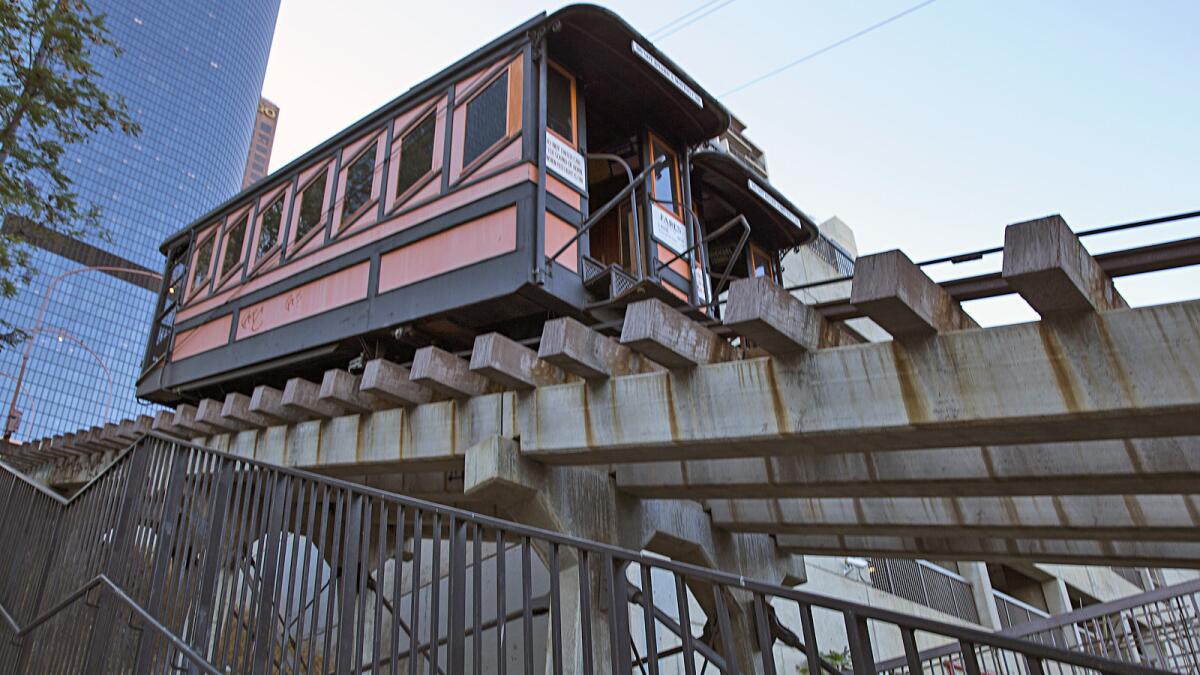L.A. business and cultural leaders want to see an Angels Flight plan

The Angels Flight funicular in downtown Los Angeles has been shut down since 2013.
- Share via
Two years ago, the Angels Flight railway made a final clattering descent down its Bunker Hill incline after one of the twin cars slipped off the track, leaving its sole passenger — an Australian tourist — startled but unhurt.
Today, the downtown funicular’s cars — Sinai and Olivet — perch motionless, halfway up. Trash has accumulated underneath the railway supports, and graffiti has appeared on the side of a car.
The railway’s orange arches and 298 feet of track have held a special place in Los Angeles lore, a quirky landmark for tourists and a reminder of a bygone era in a city where history is too often erased. And fans have lamented its silence.
“It’s so much fun to ride and has so much historical significance that we think of it as a novelty sometimes,” said Mark Murphy, executive director of the downtown theater REDCAT. “It’s actually an important economic link.”
On Thursday, a growing clamor to restore and reopen Angels Flight reached the Los Angeles County Metropolitan Transportation Authority board, even though the rail is regulated by the state’s utilities commission. Metro officials agreed to at least study its safety record and search for possible ways to get the trains running again.
Downtown business and cultural leaders urged the agency to help, saying that while the quaint cars are a tourist attraction, their 50-cent fares also provide an important physical connection between the Historic Core and Bunker Hill.
State regulators, noting a string of safety problems, including a death in 2001, have refused to allow Angels Flight to reopen until operators make safety upgrades. That includes raising the height of the train’s doors to prevent passengers from being flung out during a sudden stop; building an evacuation walkway should the cars stall halfway up; and submitting a plan detailing how they will keep passengers safe.
“They have not done so, in spite of our offers to help,” Constance Gordon, a California Public Utilities Commission spokeswoman, said in an email. “This is a requirement for all rail transit operations in California.”
It’s not clear how much an evacuation walkway would cost, said Hal Bastian, president of the Angels Flight Railway Foundation, but it could be a “very significant number.” Planning its route is the first step, he said, to “give donors confidence that it can be done.”
Los Angeles Mayor Eric Garcetti, who introduced the Metro motion, said he didn’t want the authority to start paying for the trains. But advocates, seeing a glimmer of hope, say the agency could easily make room in its budget for the funicular’s $360,000 annual operating cost.
“It would be in the best interest of everyone that Metro take over the finances and operations,” Bastian said. “That’s what they do. They run transportation.”
A week ago, two local tour company owners started a petition asking Garcetti to help speed things up. In the letter on change.org, petitioners wrote that they hoped cars would be running along the route before its 115th birthday at the end of the year. Los Angeles, they wrote, “does not have much that is that old or wonderful.”
By Thursday, more than 1,800 people had signed the document.
“It’s just breaking my heart that Angels Flight is stuck,” said Richard Schave, who co-wrote the petition. “It’s a tremendous connection to the past, and I believe the past is important.”
Angels Flight was built in 1901, two blocks from its current location. For a penny a ride, it carried residents of luxe homes on Bunker Hill to jobs in downtown. By the 1950s, it had carried more than 100 million passengers.
But as the city’s wealthiest residents moved to the suburbs, downtown — and Angels Flight — fell on hard times. In 1969, the railway was closed as crews bulldozed Bunker Hill and replaced run-down housing with modern skyscrapers.
The railroad reopened in 1996, carrying passengers on a 33-degree ride from Hill Street to California Plaza on Olive Street.
Five years later, the funicular saw its worst accident when Sinai careened down the hill and struck Olivet, killing an 83-year-old tourist from New Jersey and injuring seven others. Investigators eventually concluded that faulty mechanical and brake systems, combined with weak oversight, led to the crash. The railway was closed for the next nine years.
NEWSLETTER: Get essential California headlines delivered daily >>
In the weeks before the 2013 derailment, the cars had been running in stops and starts. A National Transportation Safety Board investigation found that the operators had been using a small tree branch to override the train’s emergency stop settings.
“Angels Flight does not have a suitable evacuation route — walkways, railings or guide ropes — to prevent passengers or emergency rescue personnel from falling onto the sidewalk 25 feet below,” investigators wrote. Video reviewed by the agency showed one passenger emerging from the stranded car and crawling along the tracks to the upper platform.
Today, Angels Flight’s orange-and-black cars sit idle. Inside one of the empty cars, an advertisement on a wall says, “Things Are Looking Up.”
Taped to the glass of an empty ticket booth is a notice dated August 2014 that says maintenance and improvements were completed in February of 2014 but that “the Railway cannot reopen for public service until State regulatory approval is granted. … We apologize for the inconvenience.”
As she walked up the 120-some concrete stairs parallel to the tracks, Maryann Nielsen of Silver Lake looked at the cars and shook her head. “It’s a shame, isn’t it?”
A few weeks ago, Nielsen came downtown with her 18-year-old daughter and a friend who was visiting from San Francisco. They don’t come downtown often, and Nielsen wanted to show them the Bradbury Building, Grand Central Market and Angels Flight — not realizing the train was still closed.
“I was so sad because I was really proud of it,” Nielsen said. “It’s such a unique L.A. thing.”
She added: “They’ve got to be able to figure out how to make it safe. I mean, come on. It goes up and down a hill. We can do a lot of things. We can make a little train safe.”
Follow @laura_nelson for more transportation news.
ALSO
DWP nonprofits slow to make reforms called for in city audit
Sanctuary cities: How Kathryn Steinle’s death intensified the immigration debate
Childhood-welfare agency worries proposed cigarette tax increase would reduce funding
More to Read
Sign up for Essential California
The most important California stories and recommendations in your inbox every morning.
You may occasionally receive promotional content from the Los Angeles Times.











